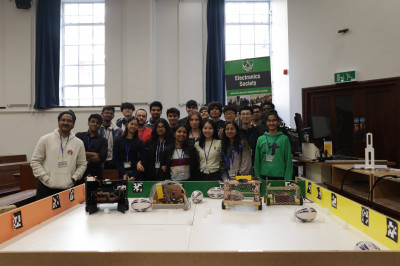News
Electronics Society takes third place at Unibots
7 April 2025

Students from the School of Electronic Engineering and Computer Science and the School of Engineering and Materials Science achieved outstanding success at the renowned Unibots UK competition, held annually at the University of Cambridge. Competing against teams from six universities - including Cambridge, King’s College London, and Heriot-Watt - Queen Mary students brought home multiple awards, showcasing their engineering creativity and teamwork.
Unibots UK is a national autonomous robotics competition that attracts student clubs and academics from across the UK. Designed to be accessible and inclusive, the event features a simple playing field, clear rules, and a supportive atmosphere - making it ideal for newcomers and teams with limited resources. Over two days, participants take part in conferences, mini-hackathons, and the flagship ball-collection arena, which sees robots compete head-to-head in a test of skill and strategy.
This year’s competition welcomed around 80 participants across 13 teams. Queen Mary's Electronics Society fielded 23 students - more than triple the number from last year - demonstrating the growing interest and involvement in robotics at the university.
All Queen Mary participants won the Team Building Challenge, with three teams placing third, fourth, and fifth overall in the main competition. The third-place team - comprising Christina Kim, Supraja Jayakumar, Rindhiya Vishnu Shankar, Weronika Malgorzata Rdesinska, Su Myat Kyaw, Jensen Jill Rajesh, and Catharine Negansan - also took home a trophy.
Muhie Haimus, second-year Robotics student and President of the Electronics Society, praised the team's achievement:
“What made this team stand out was that none of them had prior robotics experience or had competed before. Their robot had a simple but effective design, allowing them to collect a large number of game pieces.
They were also one of the few teams who tested their robot thoroughly before the event. Although they initially tried using a YOLOv5 object detection model, it ran too slowly on the day—so they pivoted to a more reliable dead reckoning method.”
The Electronics Society continues to grow, with 95 active members and rising participation in national competitions.
Find out more about the Electronics Society and browse pictures of the event.
| Contact: | Thilina Lalithnaratne |
| Email: | t.lalitharatne@qmul.ac.uk |
| People: | Thilina DULANTHA LALITHARATNE |




